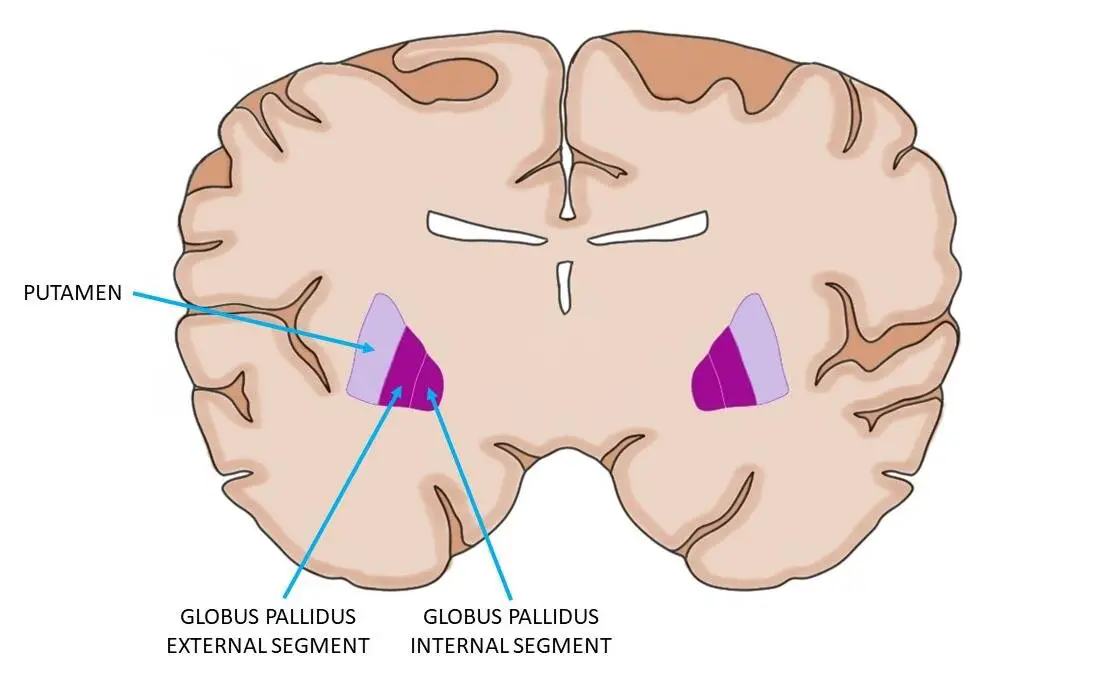Know Your Brain: Globus Pallidus
Where is the globus pallidus?

The globus pallidus is found below the cerebral cortex, adjacent to a structure called the putamen. In fact, until the first half of the 19th century the globus pallidus and putamen were considered one structure, collectively referred to as the lentiform or lenticular nucleus.
In the early 1800s, however, a German physician named Karl Burdach noted that the inner section of the lentiform nucleus has a distinct pale appearance (due to the large number of myelinated axons within it). He named this portion of the nucleus the globus pallidus, or “pale body.”
The globus pallidus itself is typically subdivided into two sections, the globus pallidus internal segment and the globus pallidus external segment.
What is the globus pallidus and what does it do?
The globus pallidus is considered part of the basal ganglia, a group of nuclei best known for their role in movement (although they are involved in a variety of cognitive and emotional functions as well). While the exact contribution of the basal ganglia to movement is still not completely understood, one popular hypothesis suggests that the basal ganglia are important for facilitating desired movements while at the same time inhibiting movements that are undesired or contradictory to a desired movement. To read more about the basal ganglia and their functions, see this article.
The different nuclei in the basal ganglia (which include the caudate, putamen, globus pallidus, substantia nigra, and subthalamic nucleus) are thought to play distinct roles in this type of movement inhibition and facilitation. The caudate and putamen, for example, receive information from the cortex about movements that you want to make—they act as the main input nuclei of the basal ganglia. The globus pallidus, on the other hand, is one of the main output nuclei of the basal ganglia (the other being the substantia nigra pars reticulata). Thus, neurons leave the globus pallidus and form a pathway (via a relay in the thalamus) that can influence neurons in the motor cortex that are responsible for initiating movements. It is through this pathway that the basal ganglia are thought to be able to regulate motor behavior.
Neurons of the globus pallidus primarily use the neurotransmitter GABA, which typically has inhibitory effects on other neurons. Thus, the output of the globus pallidus (and of the basal ganglia in general) is inhibitory. This inhibitory output is thought to occur somewhat continuously, acting to suppress movements that are unwanted. Different circuits within the basal ganglia can modulate the inhibitory activity of the globus pallidus, however, and in this way can either facilitate or suppress movement.
One circuit, for instance, known as the direct pathway, involves GABA neurons that project from the caudate and putamen (known collectively as the striatum) to the globus pallidus. When the striatum receives a signal from the cortex that a movement is desired, those GABA neurons are activated, and their activation leads to the inhibition of neurons in the globus pallidus. This puts a brief end to the globus pallidus’ inhibition of movement—allowing movement to occur. This circuit is primarily thought to involve the internal segment of the globus pallidus.
Another circuit, known as the indirect pathway, can have the opposite effect, and increase the inhibition of movement. This circuit involves a nucleus known as the subthalamic nucleus, which can act to enhance the inhibitory effects of the globus pallidus. Typically, the subthalamic nucleus is inhibited by neurons that extend from the globus pallidus external segment, but in the indirect pathway that signaling is suppressed. This leads to the subthalamic nucleus facilitating the activity of the globus pallidus internal segment, which causes increased inhibition of movement.
Due to its integral role in basal ganglia function (and thus in movement), it’s perhaps not surprising that abnormalities in globus pallidus activity have been linked to movement disorders like Parkinson’s disease and Huntington’s disease. But more recently, neuroscientists have begun to look at the role of the globus pallidus in cognition and emotion, as well as its potential contribution to non-movement disorders like depression. It’s thought, for example, that the globus pallidus may be involved with reward and motivation. Thus, continued research is likely to reveal other functions for the globus pallidus that extend far beyond its typical association with movement.
Reference (in addition to linked text above):
Purves D, Augustine GJ, Fitzpatrick D, Hall WC, Lamantia AS, Mooney RD, Platt ML, White LE, eds. Neuroscience. 6th ed. New York. Sinauer Associates; 2018.
Learn more:


